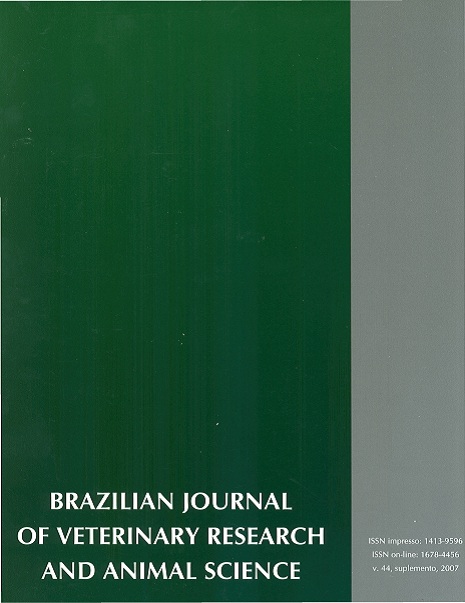Histopathological, immunohistochemical, and ultra-structural evaluation of chronic inflammatory response of robalo (Centropomus spp) to BCG
DOI:
https://doi.org/10.11606/issn.1678-4456.bjvras.2007.26591Keywords:
Fish, Histopathology, Inflammation, Epithelioid cells, GranulomaAbstract
This study set out to evaluate inflammatory response kinetics after experimental inoculation with BCG in modern Centropomus sp. fish. BCG was applied through intramuscular injection in the caudal peduncular region, and samples were collected for analyses at days 1, 3, 7, 14, 21, and 33 post-injection. Acute phase inflammatory infiltrate was characterized by predominant mononuclear cells, intersticial edema, and muscular tissue necrosis. As the inflammatory response evolved, the lesion organized into a granuloma formed by epithelioid cells. These epithelioid cells were positive for the S100 protein and cytokeratin at histochemical analysis, which demonstrates macrophage and secretory activity, besides ultra-structural analysis showed desmosomic junctions within adjacent cells. It didn't have an expressive participation of giant cells and pigment containing cells in the inflammatory reaction, suggesting that it's a specie-specific characteristic.Downloads
Download data is not yet available.
Downloads
Published
2007-12-03
Issue
Section
UNDEFINIED
License
The journal content is authorized under the Creative Commons BY-NC-SA license (summary of the license: https://
How to Cite
1.
Sado RY, Matushima ER. Histopathological, immunohistochemical, and ultra-structural evaluation of chronic inflammatory response of robalo (Centropomus spp) to BCG. Braz. J. Vet. Res. Anim. Sci. [Internet]. 2007 Dec. 3 [cited 2024 Apr. 26];44(supl.):58-64. Available from: https://www.revistas.usp.br/bjvras/article/view/26591





